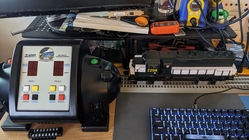A new generation of Node.JS powered control of your TMCC/Legacy/ERR engines is here! Layout Bridge Control (LBC) brings the power of different control systems under a common control schema and provides extendable methods via a REST API that you can directly interface with!
LBC is now available at the Github link below!
Github Repo link: https://github.com/SirCaptainT...ayout-Bridge-Control
Setup Guide: https://github.com/SirCaptainT...l/blob/main/SETUP.md
Current Control Systems in progress:
- TMCC (Partial)
- Legacy (Partial)
- ERR - 0% Complete
Current Controller Methods (Documentation pending for API's):
- Dualsense 5 (Playstation 5 Controller)
- HTTP Web API
Additional Support needed:
I need another CAB-2 Base for testing, if anyone would like to help support this very much still in alpha development project, and has one they wouldn't mind parting with for a fair price: https://ogrforum.ogaugerr.com/...-1l-base-legacy-base for more info. (I've had to rip the legacy base out of my layout to start doing CAB-2 development since I couldn't find one that wasn't wildly overpriced)







